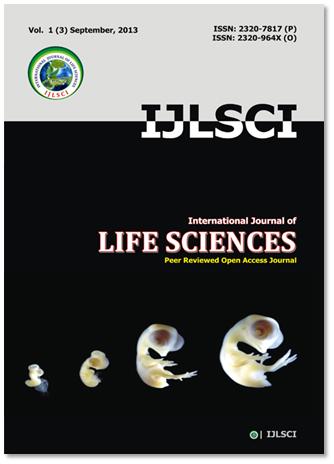Incidence of Arbuscular Mycorrhizal and Dark Septate Fungal association in Dioscorea species
Keywords:
AM fungi, DSE, Dioscorea (Yam)Abstract
Dioscorea (Yam) is a tuber crop belonging to the family Dioscoreaceae. It is among the oldest food crop and valuable source of carbohydrate in the diet. A number of Dioscorea species are also cultivated to provide a source of diosgenin, some sapogenins, alkaloids, steroid derivatives and phenolic compounds used in the pharmaceutical industry. As soil microorganisms are crucial for natural soil fertility, two species of Dioscorea from three different sites were investigated for the presence of mycorrhizal and dark septate endophytic (DSE) association. Dioscorea hispida (Dennst.) and D.bulbifera (L.) were collected from June-Nov 2011 along with their fibrous roots and rhizosphere soils. Soil physico-chemical analyses of collected samples were carried out with standard methods. All the samples were found to be colonized with arbuscular mycorrhizal and Dark Septate Endopytic fungi. The percent root colonization was in between 75 to 90.32%. AM fungal spore density was in between 185 to 296 / 100g and spores belonging to Glomus species and Acaulospora sporocarpa were identified. By inoculating the proper indigenous AMF and DSE with Dioscorea species, can produce high yield of crops in future.
Downloads
References
1. Bhat RP and Kaveriappa KM (1997a) Occurrecnce of vesicular arbuscular mycorrhizal fungi in the tubers of Gloriosa superb L. Mycorrhiza News, 15:14-16.
2. Bhat RP and Kaveriappa KM (1997b) Occurrecnce of vesicular arbuscular mycorrhizal fungi in the tubers of Colocasia esculanta (L) Schott. Mycorrhiza News, 9:12-13.
3. FAOSTAT (2007) Food and Agriculture Organization,Statistics of the United Nation, Rome,http://www.fao.org/docrep/T1696E/t1696e07.htm.
4. Gaur A and Adholeya A (1994) Estimarion of VAM spores in the soil-modified method. Mycorrhiza News, 6 (1): 10-11.
5. Gerdemann JW and Nicolson TH (1963) Spores of mycorrhizal Endogone species extracted from soil by wet – sieving and decanting. Trans .Brit. Mycol. Soc., 4 (6): 235-244.
6. Giovanneti M and Mosse B (1980) An evaluation of techniques for measuring VAM infection in roots. New Phytologist, 84: 489-500.
7. Jackson ML (1967) Soil chemical analysis. Prentice Hall Publication Pvt. Ltd, New Delhi, India: 452.
8. Khade SW and Rodrigues BF (2003) Incidence of arbuscular mycorrhizal colonization in tubers of Gloriosa superba L. Mycorrhiza News, 15(3).
9. Khade SW and Rodrigues BF (2007) Incidence of Arbuscular Mycorrhizal(AM)fungi in some angiosperms with underground storage organs from Western Ghat region of Goa, Tropical Ecology,48(1):115-118.
10. Nisha MC Subramaniam MS and Rajeshkumar S (2010) Diversity of Arbuscular Mycorrhizal fungi associated with plants having tubers of Pueraria tuberisae (Willd.)DC, Mycorrhiza News,8:9.
11. Ravi V Aked J Balagopalan C (1996) Review on tropical root and tuber crops,1.Storage methods and quality changes, Crit. Rev. Food Sci. Nutr.,36:661-709.
12. Rodrigues BF(1996) Occurrence of VAM fungi in the tubers of Pueraria tuberisae (Willd.) DC, Mycorrhiza News,8.
13. Schenck NC and Perez Y (1990) Manual for identification of VA Mycorrhizal fungi, Edited by N C Schenck N C and Y Perez, Gainesville, Florida, USA: INVAM, University of Florida Symbiosis, 3(2):249-254.
14. Sotomayor-Ramirez D Gonzalez-Velez A Roman-Paoli E (2003) Yam(Dioscorea spp.) response to fertilization in soils of the semiarid southern coast of Puerto Rico. J. Agric. Univ. Puerto Rico, 87:91-103.
15. Suja G Nair VM Saravathy P Pushpakumari R (2003) Plant population and set size effects on white yam (Dioscorea rotundata Poir.) intercropped in coconut gardens. Trop. Agric., 80:157-162.
16. Tchabi A Coyne D Hountondji F Lawouin L Wiemken A Oehl F (2008) Arbuscular mycorrhizal fungal communities in sub-Saharan savannas of Benin, West Africa, as affected byagricultural land use intensity and ecological zone. Mycorrhiza, 18:181-195.
Downloads
Published
How to Cite
Issue
Section
License
Copyright (c) 2013 Authors

This work is licensed under a Creative Commons Attribution-NonCommercial-NoDerivatives 4.0 International License.
Open Access This article is licensed under a Creative Commons Attribution 4.0 International License, which permits use, sharing, adaptation, distribution and reproduction in any medium or format, as long as you give appropriate credit to the original author(s) and the source, provide a link to the Creative Commons license, and indicate if changes were made. The images or other third party material in this article are included in the article’s Creative Commons license unless indicated otherwise in a credit line to the material. If the material is not included in the article’s Creative Commons license and your intended use is not permitted by statutory regulation or exceeds the permitted use, you will need to obtain permission directly from the copyright holder. To view a copy of this license, visit http://creativecommons.org/ licenses/by/4.0/











